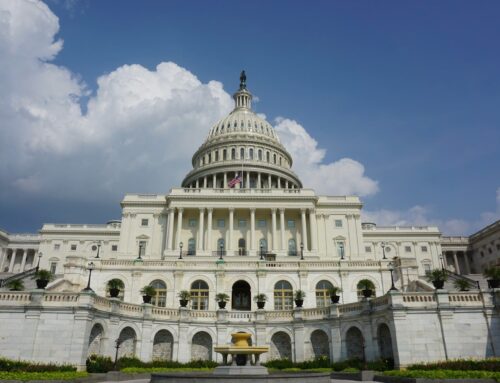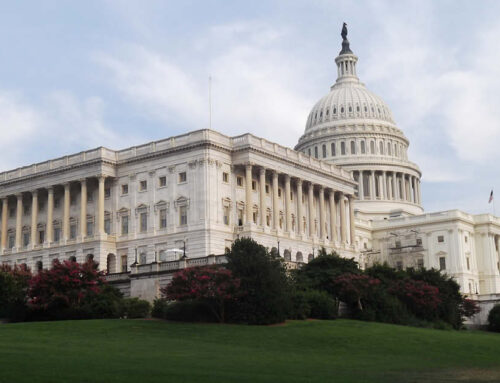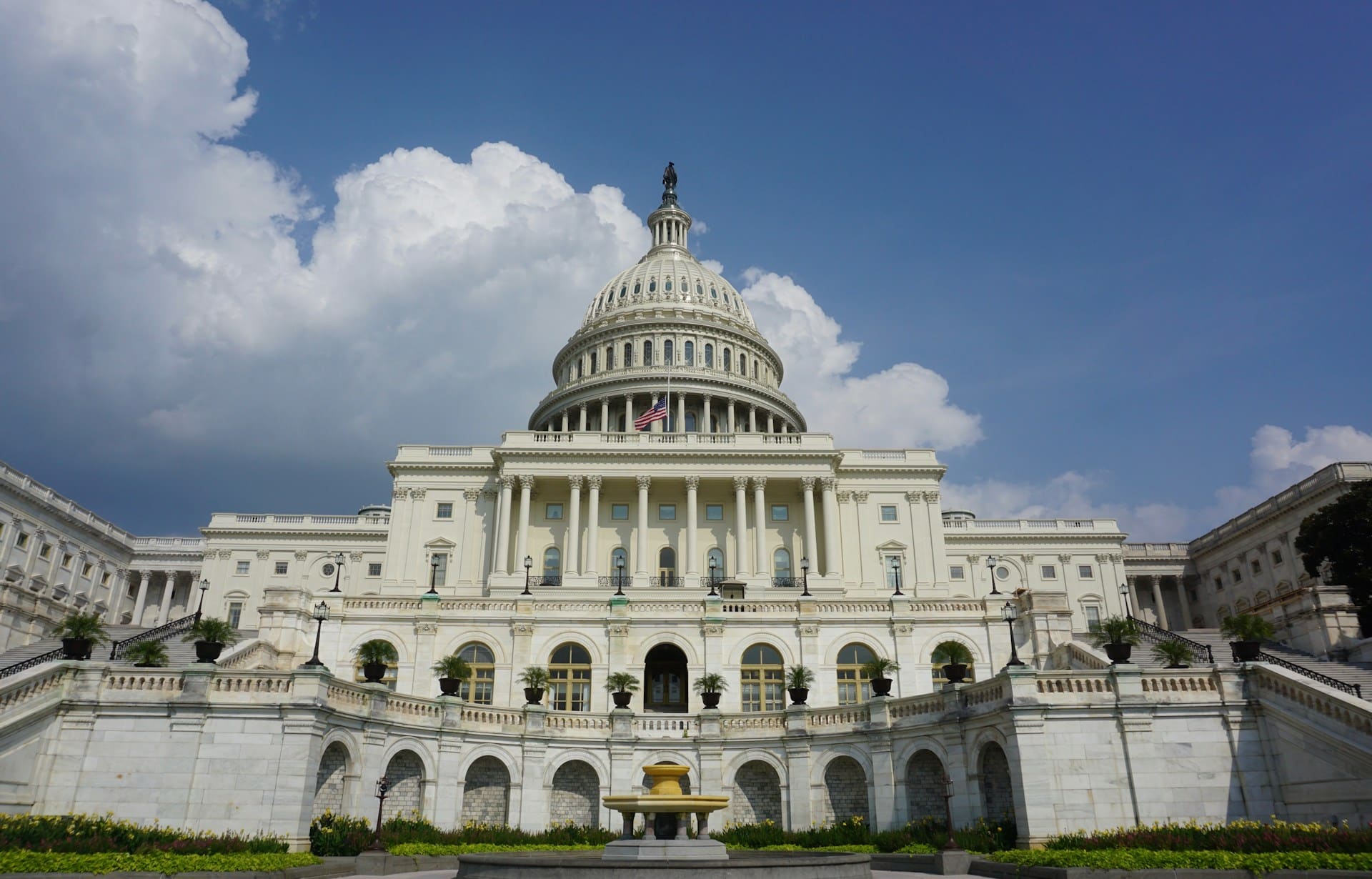On Jan. 19th, 2024, funding runs out for roughly 20 percent of the U.S. Government — including essential programs like veterans assistance and food and drug safety services. The funding for the rest of the government runs out on Feb. 2. Hit play to get up to speed on the state of play in Congress with Host Steve Ellis and special guests Josh Sewell and Mike Surrusco.
Transcript
Announcer:
Welcome to Budget Watchdog All Federal, the podcast dedicated to making sense of the budget, spending and tax issues facing the nation. Cut through the partisan rhetoric and talking points for the facts about what’s being talked about, bandied about and pushed in Washington. Brought to you by Taxpayers For Common Sense. And now, the host of Budget Watchdog AF, TCS President, Steve Ellis.
Steve Ellis:
Welcome to all American taxpayers seeking common sense. You’ve made it to the right place. For over 25 years, TCS, that’s Taxpayers For Common Sense, has served as an independent, non-partisan budget watchdog group based in Washington, DC. We believe in fiscal policy for America that is based on facts. We believe in transparency and accountability because, no matter where you are on the political spectrum, no one wants to see their tax dollars wasted.
Happy New Year, everyone. It’s 2024 and we are back on the brink. On January 19th, funding runs out for roughly 20% of the government, including for central programs such as some veteran’s assistance, and food and drug safety services. The funding for the rest of government runs out on February 2nd. Joining me now to get us all up to speed on the state of planning in Congress is Joshua Sewell, TCS director of research and policy, and Mike Surrusco, TCS director of campaigns. Gentlemen, thanks for being here.
Josh Sewell:
Hey, happy new year.
Mike Surrusco:
Hey, guys.
Steve Ellis:
Josh, let’s start with you. Even before this Congress was gaveled back into session by Speaker Mike Johnson, word came that a new bipartisan deal on the fiscal ’24 budget caps had been agreed to in principle. Break it down for our listeners. What’s the top line number and what programs seemed to have been spared the ax?
Josh Sewell:
Steve, new year, new deal. Although, I got to say, this one looks a lot like the old 1.66 trillion or so deal that former Speaker McCarthy actually hammered out with Senate Dems in the White House last June. Defense has a top line of about $886 billion. Non-defense spending, a technical cap of $704 billion.
Steve Ellis:
All right, carry the one. 886 plus 704 is not 1.66. What are we missing?
Josh Sewell:
That pseudo offset sidecar, as I’d call it. $704 billion, that is the top line. But in the debt limit deal negotiations, way back times of last year, it was agreed that in the actual writing of the spending bills that Congress and the Senate would provide nearly $70 billion more in non-defense spending.
Steve Ellis:
Okay. Can you explain to our faithful podcast listeners how you get additional spending without budgeting for additional spending?
Josh Sewell:
Washington math. It’s mainly by clawing back a number of funds. The negotiators agreed to rescind, which is basically cancel, billions in unspent COVID-19 response dollars, as well as $20 billion provided to the IRS as part of their pot of funds from the Inflation Reduction Act.
Steve Ellis:
So this is a pseudo sidecar for two reasons. One, it’s not in agreement with legislative text, it’s just between the two leaders. And two, the COVID and IRS money is a rescission and re-appropriation so there is no “new spending.”
Josh Sewell:
Yeah, exactly. But I have to say, especially with the COVID dollars, those aren’t needed for their original purpose. That’s why they are unspent. They’ve been sitting around for a year, two, three years in some instances. They should just be rescinded and that savings banked for taxpayers. But from a technical budgeting perspective, those claw backs are not new spending. But let’s be honest, for normal people and basic common sense, they are and that’s why the price tag is higher than it looks at first.
Steve Ellis:
Right. And actually, as we’ve talked about on the pod before, the IRS funding claw back actually is even more costly because it adds to the deficit. That’s not just TCS or me talking, it’s the Congressional budget office.
All right. Mike, we’ve talked about this so-called laddered CR, with a bifurcated expiration. Let’s turn to that, I mentioned it at the top. What is in the one that’s expiring on January 19th, the most imminent threat?
Mike Surrusco:
In about a week, there are four appropriations bills that need to be passed through the House and Senate, and agreed to, and signed into law. Otherwise, the funding for those departments will essentially stop. That includes agriculture, rural development, the FDA, those are bundled together. Then you’ve military construction and Veteran’s Affairs is one. Then, you have transportation, housing and urban development. And then, energy and water.
This was part of the agreement that was made to try and prevent a shutdown at the end of last year. Then, there’s a second set of deadlines coming up in February, which is basically everything else.
Steve Ellis:
Gotcha. As I think about this, it seems like there might be some sort of rhyme or reason why those four bills were picked. Do you have any insight into that, mike?
Mike Surrusco:
Well, I think idea was that these are the less painful than the Department of Defense, for example. Some agencies that are affected by this first deadline, like the VA, do have funding that extends out beyond the current fiscal year. It wasn’t random. They certainly did this … Congress likes to give itself lots of deadlines. For better or worse, that’s the only way anything gets done. In this case, even if they blow through these deadlines, the hope here was that this would pass and it did, and now we are quickly approaching the first deadline and Congress still has a lot of work to do in the next week.
Steve Ellis:
Right. Well, you mentioned the VA having advanced funding for veteran’s health. Something that actually came into pass several years ago, because of the shutdown, so they wanted to make sure that that didn’t happen again. But then, you also have, as Mr. Agriculture, you’ll be happy to talk about, but you have funding through the extension of the Farm Bill and some of the slush funds that the USDA has. The Core of Engineers, and energy and water, they’re awash in cash. MilCon is five-year funding, is not really affected. The transportation, they’ve already done the five-year highway bill. I think you’re right, Mike, that a lot of these were meant to be not as painful as, like you said, having DHS, or DOD, or Labor, Health and Human Services, having those actually shut down.
That’s the CR aspect, that’s the triggering mechanism. Now going back to this agreement, House Freedom Caucus members, it seems to be about as unhappy with this deal as they were with the last deal, the one that led to the firing of Speaker McCarthy. Is this compromise, as Representative Bob Good, the head of the Freedom Caucus told the Washington Post last week, “bad for the American people, the deficit and the national debt?”
Josh Sewell:
I think that’s a little much. But let’s point out that there are definitely some members of the GOP who are very upset. As evidence, one of the first acts in returning to Congress this week is that 13 of them actually tanked a procedural vote that would have set debate on some non-controversial bills. At least, things that they supported, a couple Congressional review acts where they were going to just approve of some things that the Administration is doing.
This is the tactic that they used, many of them used, against Speaker McCarthy in the past. And actually, Mr. Johnson as well. To basically express their displeasure with what he’s doing by scuttling what is normally a routine vote and partisan vote on the floor, just to get the attention.
Mike Surrusco:
Yeah. I honestly was surprised when the news came out that they had struck this deal that was so in line with the original agreement, considering what happened to McCarthy. With that in mind, I would be surprised if we went through the same scenario again, of vacating the chair and going through all of the rounds of trying to elect a new Speaker. As you recall, at one point, Mike Rogers from Alabama was practically coming to fisticuffs with Representative Gates, as they were trying to come up with a candidate that they could elect as the new Speaker. I don’t think that’s going to happen again, even though there’s been some threats to vacate Speaker Johnson, just like Speaker McCarthy. I guess the question is where do we go from here?
Steve Ellis:
Right. Well, it does make you wonder though, who is on that Acting Speaker list that Speaker Johnson had to submit? I’m assuming it’s not Congressman McHenry again. But anyway, I digress.
It seems like the frustration, or it’s just an acknowledgement that it’s time to move on. That this top line, they agreed to it, they’ve got Senate majority leader Schumer on board, they got the White House on board. And that, here we are, we’re already into the fourth month of the fiscal year and it’s time to move on. Would you gentlemen agree with me on that?
Josh Sewell:
Yeah. I think frankly, it’s just math. Both arithmetic and political math. It’s an election year and we’re actually moving up onto the next fiscal year spending bill process. It should be starting any day now, with the President’s State of the Union coming up, and then the regular budget process.
Mike Surrusco:
I was going to say, they’re obviously running out of time. There’s been some discussion about doing yet another CR to give them enough time to put together all of the appropriations bills that get us to the top lines that they’ve agreed to. Which is another political hand grenade for Speaker Johnson to deal with, because he essentially took that role vowing not to continue funding the government through continuing resolutions. But it seems unlikely that we’re going to get enough done between now and the 19th, so there is, I think, a strong possibility that at least part of the government will shut down then.
Steve Ellis:
[inaudible 00:11:05] in a CR. Part of the rationale for giving them this time and this laddered CR was that then there wouldn’t be some huge omnibus package. That they would be considering these bills and some semblance of regular order, and the fact that it would be mini buses or it would be individual spending bills. Is there any prognosis for anything like that, especially if there’s a short term CR?
Josh Sewell:
It gets back to they tried this process in the fall, they being the House, got as far as they could. But I think this is just … I don’t know how many times we can say this but we need it, is that this is just the reality is you got the gains you can, move onto the next big spending fight.
Let’s make it clear. I think you can … The Speaker and others are arguing that this is a win, and I agree with them to a certain extent. They’ve gotten what they can. And actually, that sidecar deal, as annoying as it is to me, as someone who doesn’t like to rescind funds that we’re not going to spend and pretend like that’s not new spending, they actually are rescinding even more than they were in the previous deal. So an extra $6 billion in COVID funds that, if they had passed these bills in the fall, would not have been rescinded. That $20 billion, not a big fan of taking that from the IRS because I think it’s going to do some damage, but if you wanted to get rid of that spending, well now they’re going to do all 20 billion this fiscal year. Instead of doing 10 this year, and 10 next year.
Those are incremental wins. But hey, Washington’s all about increments, right? We didn’t get to where we are from one fell swoop, so it’s going to take a lot of small changes and some big changes to get to where we need to be.
Mike Surrusco:
Yeah. On the big changes, all of this speaks to the dysfunction in the appropriations process at large. And that in the last four decades, there’s only been a handful of years when Congress has appropriated money the way that it’s supposed to be done under regular order. So perhaps, it’s time for another fiscal commission that we have talked about, others have talked about, similar to ones that happened in the past, to try and at least have some discussion about the process in the Congress about how money is appropriated each year because the current system is broken.
Steve Ellis:
Yeah. If memory serves, the appropriations, just having all the bills done, even if they were done in mini buses or whatever, having all the bills done before the October 1st start of the fiscal year has happened precisely four times in the last 50 years, since the 1974 Budget Act. We certainly, in a podcast, I think two ago, podcast listeners please go back and listen, we did talk about the fiscal commission. It’s something that TCS has decided to put our shoulder to the wheel and try to push something like that forward.
Josh, you mentioned “get to the next spending fight.” And actually, the next spending fight is right here. We’ve got, in addition to FY24 appropriations, there is this whole fight over supplemental spending that is riding on a parallel track with this. It seems like it has the Ukraine funding, it has Israel funding, it has potentially a border deal, which all of this seems to tie on. Is there any insight as to what’s happening there? Or if this might just move, even without that?
Josh Sewell:
The current request basically started back in August. This has been marinating for months. It’s grown in size, to cover more than 104 billion. I think if you add a couple other things, it could be 113, 115, 130. It’s just a question of how large it gets, especially with the border in there.
Yeah, it could be a parallel track. But the way Washington typically works is there’s a very limited amount of time to do anything, and it’s easier to do a bunch of things in one big bill. Whether our personal distaste and many members of Congress express displeasure with those omnibus packages, but they can’t seem to shake them. I don’t know if it’s optimism, but I believe that there will be a supplemental package, and it will come out and be agreed to pretty quick. The biggest issue is the border. The Administration has requested tens of billions of dollars in border security funding, but it’s some of the policy prescriptions that are holding things up right now.
But I do have to say, again, there are some legitimate emergency interests going on now, but this just gets to another thing that we’ve criticized numerous times of there’s a lot of things being treated as a budgetary emergency that aren’t necessarily a true emergency as most people would think of an emergency.
Steve Ellis:
All right. Mike, we talked about a CR and the anathema of particularly members of the House Republican conference to doing these CRs. They put a, I don’t want to call it a poison pill, but certainly a deterrent of doing longterm CRs into the Fiscal Responsibility Act this past summer, that extended the debt ceiling deal. What is that deterrent that they have in there? I know you’ve written extensively about this.
Mike Surrusco:
Well, part of the goal of that deal was to get at, whether it piecemeal or on the margins, this broken budget process that I mentioned. As part of the raising of the debt limit to avoid a default, which is a separate issue that we, I think, have discussed before too, they put in automatic reductions for both defense and non-defense funding if Congress passing another continuing resolution that extends into 2024. Those cuts would go into effect at the end of April.
Again, Congress likes to give itself lots of deadlines, with the hope that it forces their hand. Maybe, you can say that it’s worked this time since there has been this breakthrough, at least at the top lines total spending during FY24. We’ll see what happens, if they can get the brass tacks worked out in time. But if they do pass a CR and it extends beyond April, like a full year continuing resolutions for example, then these automatic cuts would be triggered pursuant to the Fiscal Responsibility Act, which was the deal between McCarthy and the White House back last summer.
It’s called sequestration, which is not actually spending cuts. It’s more of a limit to spending increases. We’ve criticized it is a very blunt tool. But unfortunately, it has emerged as one of the few ways to actually reign in spending because nobody seems to agree on what needs to be cut.
Steve Ellis:
Thank you, Mike. So then, we’re less than a month away from when the President is actually legally mandated to send his budget, his FY25 budget, to the Congress. It seems surreal that we’re still fighting over FY24. And actually, the second of the CRs expires basically right about the same time that the budget’s supposed to be submitted. What are your guys’ thoughts about the FY25 budget and prognosis for getting that done?
Josh Sewell:
I just say, let’s move on. I’m ready. I think it’s time to put a pin in this conversation about fiscal year 2024.
I saw a stat today also that, at the current levels, I think with this agreement, the fiscal year ’24 discretionary spending, which is what we’re talking about, both defense and non-defense discretionary, will be, according to the CBO, at the same percentage of our GDP as it was in 1996. The discretionary budget has gone up. It has not accelerated nearly as much as other parts of the budget.
You’ve done what you can. Fiscal year 2024 is basically halfway over. Let’s just move onto the next fight. I think I want it to be the supplemental spending bill, how to figure out how to pay for parts of that that need to be paid for. But, that should be a quick debate, too. Let’s move on to 2025. I’m always an optimist. Even in an election year, even in a Presidential election year, even with only a … what do they have a two vote margin, I think, in the House right now, Republicans? They all ran to do a job, there’s enough of them if they agree to do the job, there will be a bipartisan solution to any problem. Let’s move on, let’s have some substantive debates and let’s do it.
Steve Ellis:
Hear, hear. Josh Sewell and Mike Surrusco, thanks for braving the brink and bringing things into better focus today.
Josh Sewell:
New year, new hope.
Mike Surrusco:
My pleasure, Steve.
Steve Ellis:
Well, there you have it, podcast listeners. Where and how we spend our money matters. This is the frequency, mark it on your dial, subscribe and share. And know this, Taxpayers For Common Sense has your back, America. We read the bills, monitor the earmarks, and highlight those wasteful programs that poorly spend our money and shift longterm risk to taxpayers. We’ll be back with a new episode soon. I hope you’ll meet us right here to learn more.









Get Social